Quasi-Targeted Metabolomics Approach Reveal the Metabolite Differences of Three Poultry Eggs
Abstract
:1. Introduction
2. Materials and Methods
2.1. Egg Preparation
2.2. Metabolites Extraction
2.3. LC-MS/MS Analysis
2.4. Identification and Quantification of Metabolites
2.5. Data Analysis
3. Results
3.1. Metabolic Profiling
3.2. Multivariate Statistical Analysis
3.3. Identification of Differential Metabolites
3.4. KEGG Annotation and Enrichment Analysis of Differential Metabolites
4. Discussion
4.1. Metabolites Identified in the Three Types of Eggs
4.2. Metabolites Identified in the Egg Yolks and Albumens
5. Conclusions
Supplementary Materials
Author Contributions
Funding
Data Availability Statement
Acknowledgments
Conflicts of Interest
Glossary
| AMP | Adenosine 5′-monophosphate |
| cGMP-PKG | Cyclic guanosine monophosphate-protein kinase G |
| CE | Collision energy |
| D | Duck egg |
| DW | Duck albumen |
| DY | Duck egg yolk |
| DP | Declustering potential |
| FC | Fold change |
| H | Chicken egg |
| HMDB | Human Metabolome Database |
| HW | Chicken albumen |
| HY | Chicken egg yolk |
| IMP | Inosine-5′-monophosphate |
| KEGG | Kyoto Encyclopedia of Genes and Genomes |
| LC-MS | Liquid chromatograph-mass spectrometer |
| LC-MS/MS | Liquid chromatography-tandem mass spectrometry |
| MRM | Multiple reaction monitoring |
| PCA | Principal component analysis |
| PLS-DA | Partial least-squares discriminant analysis |
| Q | Quail egg |
| QW | Quail albumen |
| QY | Quail egg yolk |
| RT | Retention time |
| VIP | Variable important in projection |
References
- Kovacs-Nolan, J.; Phillips, M.; Mine, Y. Advances in the value of eggs and egg components for human health. J. Agric. Food Chem. 2005, 53, 8421–8431. [Google Scholar] [CrossRef] [PubMed]
- FAOSTAT. 2019. Available online: http://www.fao.org/faostat/en/#home (accessed on 12 December 2021).
- Goto, T.; Fernandes, A.F.A.; Tsudzuki, M.; Rosa, G.J.M. Causal phenotypic networks for egg traits in an f2 chicken population. Mol. Genet. Genom. 2019, 294, 1455–1462. [Google Scholar] [CrossRef] [PubMed]
- Kralik, G.; Kralik, Z. Poultry products enriched with nutricines have beneficial effects on human health. Med. Glas. 2017, 14, 1–7. [Google Scholar]
- Laudodio, V.; Lorusso, V.; Lastella, N.M.B.; Dhama, K.; Karthik, K.; Tiwari, R.; Alam, G.M.; Tufarelli, V. Enhancement of nutraceutical value of table eggs through poultry feeding strategies. Int. J. Pharmacol. 2015, 11, 201–212. [Google Scholar] [CrossRef] [Green Version]
- Rehault-Godbert, S.; Guyot, N.; Nys, Y. The golden egg: Nutritional value, bioactivities, and emerging benefits for human health. Nutrients 2019, 11, 684. [Google Scholar] [CrossRef] [Green Version]
- Roberts, J.R. Factors affecting egg internal quality and egg shell quality in laying hens. J. Poult. Sci. 2014, 41, 161–177. [Google Scholar] [CrossRef] [Green Version]
- Wilson, P.B. Recent advances in avian egg science: A review—Sciencedirect. Poult. Sci. 2017, 96, 3747–3754. [Google Scholar] [CrossRef]
- Goto, T.; Tsudzuki, M. Genetic mapping of quantitative trait loci for egg production and egg quality traits in chickens: A review. J. Poult. Sci. 2017, 54, 1–12. [Google Scholar] [CrossRef] [Green Version]
- Nishibori, M.; Tsudzuki, M.; Hayashi, T.; Yamamoto, Y.; Yasue, H. Complete Nucleotide Sequence of the Coturnix Chinensis (Blue-Breasted Quail) Mitochondorial Genome and a Phylogenetic Analysis with Related Species. J. Hered. 2002, 93, 439–444. [Google Scholar] [CrossRef] [Green Version]
- Hu, S.; Qiu, N.; Liu, Y.; Zhao, H.; Gao, D.; Song, R.; Ma, M. Identification and comparative proteomic study of quail and duck egg white protein using 2-dimensional gel electrophoresis and matrix-assisted laser desorption/ionization time-of-flight tandem mass spectrometry analysis. Poult. Sci. 2016, 95, 1137–1144. [Google Scholar] [CrossRef]
- Chi, S.P.; Tseng, K.H. Physicochemical properties of salted pickled yolks from duck and chicken eggs. J. Food Sci. 1998, 63, 27–30. [Google Scholar] [CrossRef]
- Andrabi, S.M.H.; Ansari, M.S.; Ullah, N.; Anwar, M.; Mehmood, A.; Akhter, S. Duck egg yolk in extender improves the freezability of buffalo bull spermatozoa. Anim. Reprod. Sci. 2008, 104, 427–433. [Google Scholar] [CrossRef] [PubMed]
- Arshad, R.; Meng, Y.; Qiu, N.; Sun, H.; Keast, R.; Rehman, A. Phosphoproteomic analysis of duck egg white and insight into the biological functions of identified phosphoproteins. J. Food Biochem. 2020, 44, e13367. [Google Scholar] [CrossRef]
- Liu, Y.; Qiu, N.; Gao, D.; Ma, M. Comparative proteomic analysis of chicken, duck, and quail egg yolks. Int. J. Food Prop. 2018, 21, 1311–1321. [Google Scholar] [CrossRef] [Green Version]
- Weckwerth, W. Metabolomics in systems biology. Annu. Rev. Plant Biol. 2003, 54, 669–689. [Google Scholar] [CrossRef] [PubMed]
- Griffiths, W.; Koal, T.; Wang, Y.; Kohl, M.; Enot, D.; Deigner, H.P. Targeted metabolomics for biomarker discovery. Angew. Chem. Int. Ed. 2010, 49, 5426–5445. [Google Scholar] [CrossRef] [PubMed]
- Li, B.; He, X.; Jia, W.; Li, H. Novel applications of metabolomics in personalized medicine: A mini-review. Molecules 2017, 22, 1173. [Google Scholar] [CrossRef] [PubMed] [Green Version]
- Wishart, D.S. Metabolomics: Applications to food science and nutrition research. Trends Food Sci. Technol. 2008, 19, 482–493. [Google Scholar] [CrossRef]
- Cubero-Leon, E.; Pealver, R.; Maquet, A. Review on metabolomics for food authentication. Food Res. Int. 2014, 60, 95–107. [Google Scholar] [CrossRef]
- Bundy, J.G.; Davey, M.P.; Viant, M.R. Environmental metabolomics: A critical review and future perspectives. Metabolomics 2009, 5, 3–21. [Google Scholar] [CrossRef]
- Macel, M.; Van Dam, N.M.; Keurentjes, J.J. Metabolomics: The chemistry between ecology and genetics. Mol. Ecol. Resour. 2010, 10, 583–593. [Google Scholar] [CrossRef]
- Want, E.J.; Masson, P.; Michopoulos, F.; Wilson, I.D.; Theodoridis, G.; Plumb, R.S.; Shockcor, J.; Loftus, N.; Holmes, E.; Nicholson, J.K. Global metabolic profiling of animal and human tissues via UPLC-MS. Nat. Protoc. 2013, 8, 17–32. [Google Scholar] [CrossRef]
- Luo, P.; Dai, W.; Yin, P.; Zeng, Z.; Kong, H.; Zhou, L.; Wang, X.; Chen, S.; Lu, X.; Xu, G. Multiple reaction monitoring-ion pair finder: A systematic approach to transform nontargeted mode to pseudotargeted mode for metabolomics study based on liquid chromatography-mass spectrometry. Anal. Chem. 2015, 87, 5050–5055. [Google Scholar] [CrossRef]
- Kanehisa, M.; Goto, S. KEGG: Kyoto encyclopedia of genes and genomes. Nucleic Acids Res. 2000, 28, 29–34. [Google Scholar] [CrossRef]
- Menezes, P.; Lima, E.; Medeiros, J. Oliveira W and J Evêncio-Neto, Egg quality of laying hens in different conditions of storage, ages and housing densities. Rev. Bras. De Zootec. 2012, 41, 2064–2069. [Google Scholar] [CrossRef] [Green Version]
- Venkatachalam, K.; Nagarajan, M. Assessment of different proteases on degree of hydrolysis, functional properties and radical scavenging activities of salted duck egg white hydrolysate. J. Food Sci. Technol. 2019, 56, 3137–3144. [Google Scholar] [CrossRef] [PubMed]
- Hatta, H.; Kapoor, M.P.; Juneja, L.R. Bioactive Components in Egg Yolk. In Egg Bioscience and Biotechnology; Mine, Y., Ed.; Wiley: Hoboken, NJ, USA, 2007; pp. 185–237. [Google Scholar]
- Sugino, H.; Nitoda, T.; Juneja, L. (Eds.) General Chemical Composition of Hen Eggs. In Hen Eggs: Their Basic and Applied Science; CRC Press: Boca Raton, FL, USA, 1997. [Google Scholar]
- Cherian, G.; Holsonbake, T.B.; Goeger, M.P. Fatty acid composition and egg components of specialty eggs. Poult. Sci. 2002, 81, 30–33. [Google Scholar] [CrossRef]
- Chang, H.M.; Tsai, C.F.; Li, C.F. Changes of amino acid composition and lysinoalanine formation in alkali-pickled duck eggs. J. Agric. Food Chem. 1999, 47, 1495–1500. [Google Scholar] [CrossRef]
- Takehiko, Y.; Lekh, R.J.; Hajime, H.; Mujo, K. (Eds.) Hen Eggs: Their Basic and Applied Science; CRC Press: Boca Raton, FL, USA, 1997. [Google Scholar]
- Okubo, T.; Akachi, S.; Hatta, H. Structure of hen eggs and physiology of egg laying. In Hen Eggs: Their Basic and Applied Science; Yamamoto, T., Juneja, L.R., Hatta, H., Kim, M., Eds.; CRC Press: Boca Raton, FL, USA, 1997; pp. 1–12. [Google Scholar]
- MEXT Japan. Standard Tables of Food Composition in Japan 2015 (Seventh Revised Version). Retrieved from Ministry of Education, Culture, Sports, Science and Technology-Japan. 2015. Available online: http://www.mext.go.jp/en/policy/science_technology/policy/title01/detail01/1374030.htm (accessed on 19 November 2021).
- Ogura, T.; Wakayama, M.; Ashino, Y.; Kadowaki, R.; Tomita, M. Effects of feed crops and boiling on chicken egg yolk and white determined by a metabolome analysis. Food Chem. 2020, 327, 127077. [Google Scholar] [CrossRef]
- Li, X.; Huang, M.; Song, J.; Shi, X.; Chen, X.; Yang, F.; Pi, J.; Zhang, H.; Xu, G.; Zheng, J. Analysis of fishy taint in duck eggs reveals the causative constituent of the fishy odor and factors affecting the perception ability of this odor. Poulty Sci. 2019, 98, 5198–5207. [Google Scholar] [CrossRef]
- Yang, Y.; Zhao, Y.; Xu, M.; Wu, N.; Yao, Y.; Du, H.; Liu, H.; Tu, Y. Changes in physico- chemical properties, microstructure and intermolecular force of preserved egg yolk gels during pickling. Food Hydrocoll. 2019, 89, 131–142. [Google Scholar] [CrossRef]
- Liu, H.; Yang, Q.; Guo, R.; Hu, J.; Tang, Q.; Qi, J.; Wang, J.; Han, C.; Zhang, R.; Li, L. Metabolomics reveals changes in metabolite composition of duck eggs under the impact of long-term storage. J. Sci. Food Agric. 2022, 102, 4647–4656. [Google Scholar] [CrossRef]
- Santos, D.O.; Coimbra, J.S.R.; Teixeira, C.R.; Barreto, S.L.T.; Silva, M.C.H.; Giraldo-Zuniga, A.D. Solubility of proteins from quail (Coturnix coturnix japonica) egg white as affected by agitation time, pH, and salt concentration. Int. J. Food Prop. 2015, 18, 250–258. [Google Scholar] [CrossRef] [Green Version]
- Tokuşoğlu, Ö. The quality properties and saturated and unsaturated fatty acid profiles of quail egg: The alterations of fatty acids with process effects. Int. J. Food Sci. Nutr. 2006, 57, 537–545. [Google Scholar] [CrossRef]
- Miguel, M.; Manso, M.A.; López-Fandiño, R.; Ramos, M. Comparative study of egg white proteins from different species by chromatographic and electrophoretic methods. Eur. Food Res. Technol. 2005, 221, 542–546. [Google Scholar] [CrossRef]
- Tan, C.; Ji, Y.; Zhao, X.; Xin, Z.; Li, J.; Huang, S.; Cui, Z.; Wen, L.; Liu, C.; Kim, S.W.; et al. Effects of dietary supplementation of nucleotides from late gestation to lactation on the performance and oxidative stress status of sows and their offspring. Anim. Nutr. 2021, 7, 111–118. [Google Scholar] [CrossRef]
- Zhang, J.; Zhang, Y.; Wang, Y.; Xing, L.; Zhang, W. Influences of ultrasonic- assisted frying on the flavor characteristics of fried meatballs. Innov. Food Sci. Emerg. Technol. 2020, 62, 102365. [Google Scholar] [CrossRef]
- Tu, T.; Wu, W.; Tang, X.; Ge, Q.; Zhan, J. Screening out important substances for distinguishing Chinese indigenous pork and hybrid pork and identifying different pork muscles by analyzing the fatty acid and nucleotide contents. Food Chem. 2021, 350, 129219. [Google Scholar] [CrossRef]
- Zhang, N.; Wang, W.; Li, B.; Liu, Y. Non-volatile taste active compounds and umami evaluation in two aquacultured pufferfish (Takifugu obscurus and Takifugu rubripes). Food Biosci. 2019, 32, 100468. [Google Scholar] [CrossRef]
- Lee, E.Y.; Kim, S.; Kim, M.H. Aminoacyl-trna synthetases, therapeutic targets for infectious diseases. Biochem. Pharmacol. 2018, 154, 424–434. [Google Scholar] [CrossRef]
- Yi, M.; Zhai, W.; Wang, M.; Wang, H.; Liu, Z.; Gao, F.; Ke, X.; Song, C.; Cao, J.; Lu, M. The welfare of nile tilapia (Oreochromis niloticus, GIFT strain) juveniles cultured in different light spectra. Front. Mar. Sci. 2022, 9, 924110. [Google Scholar] [CrossRef]

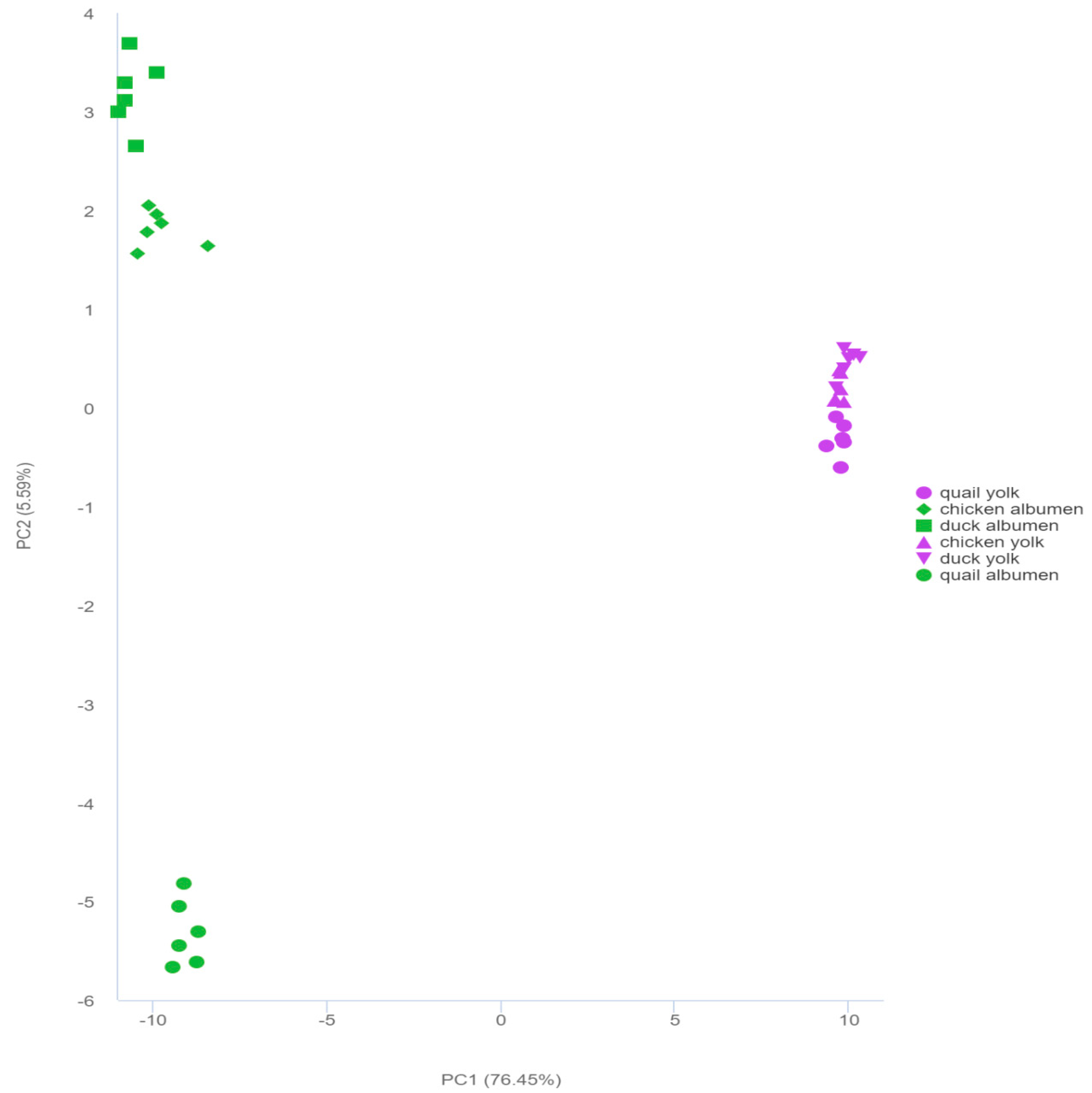
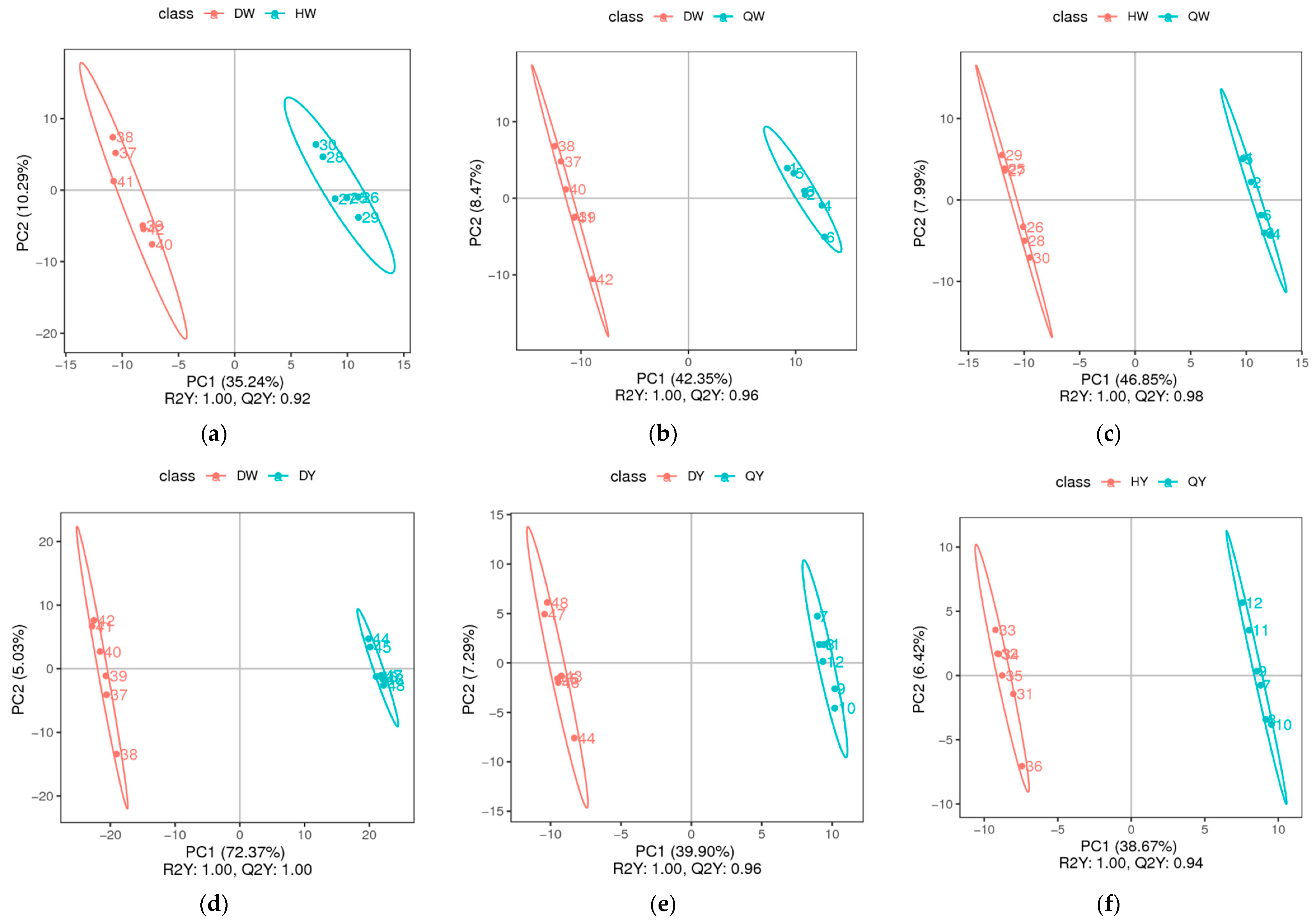
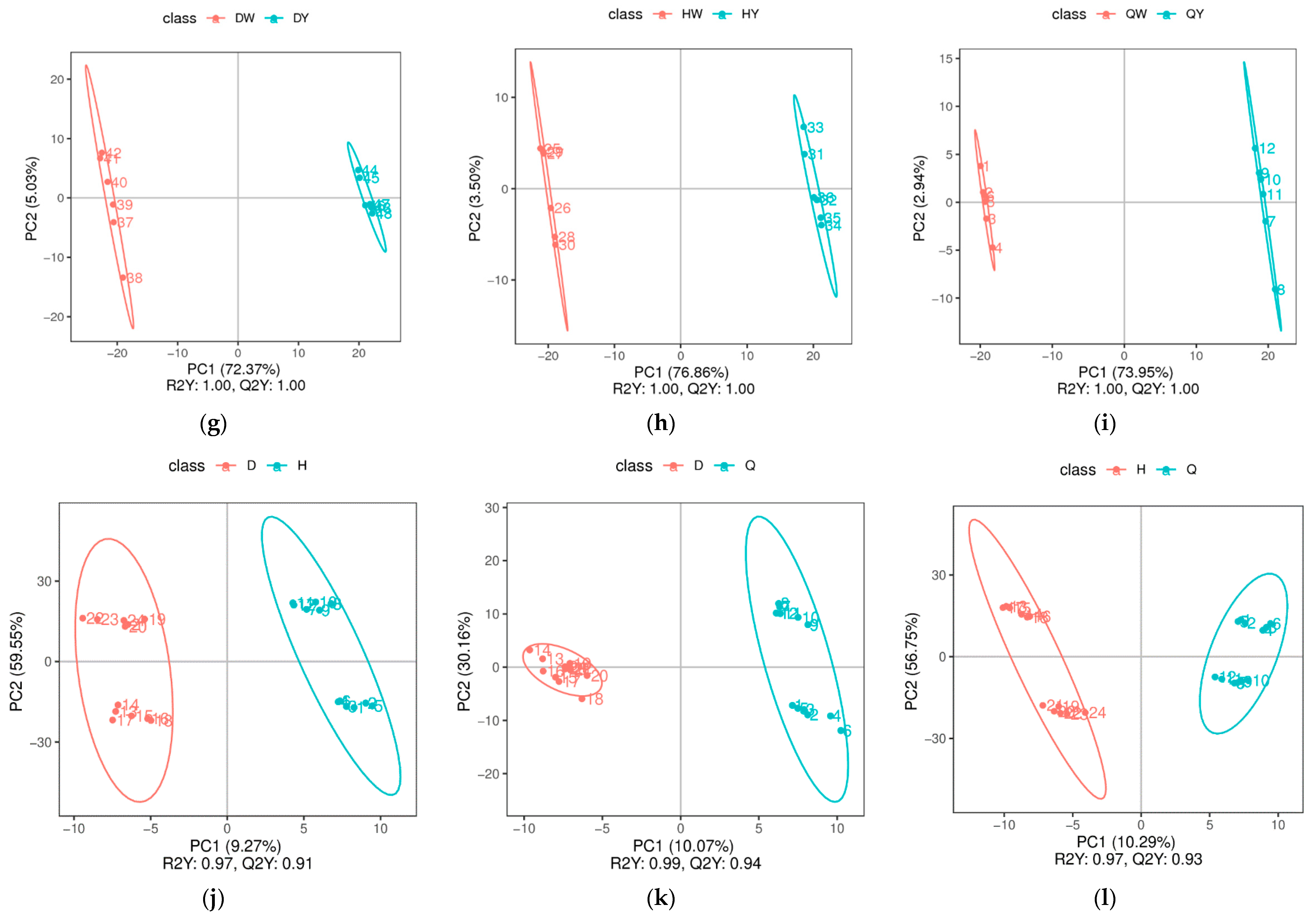
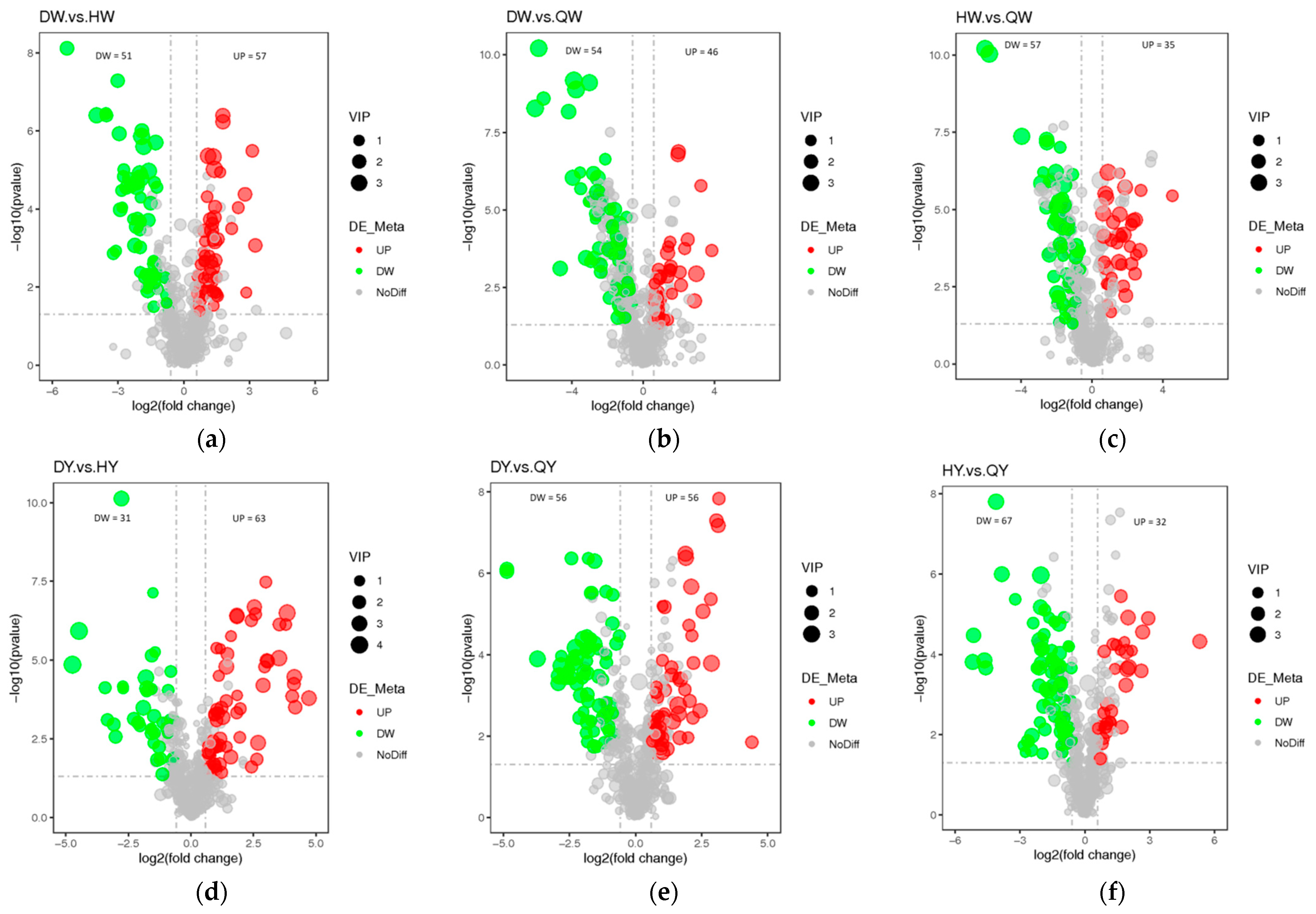
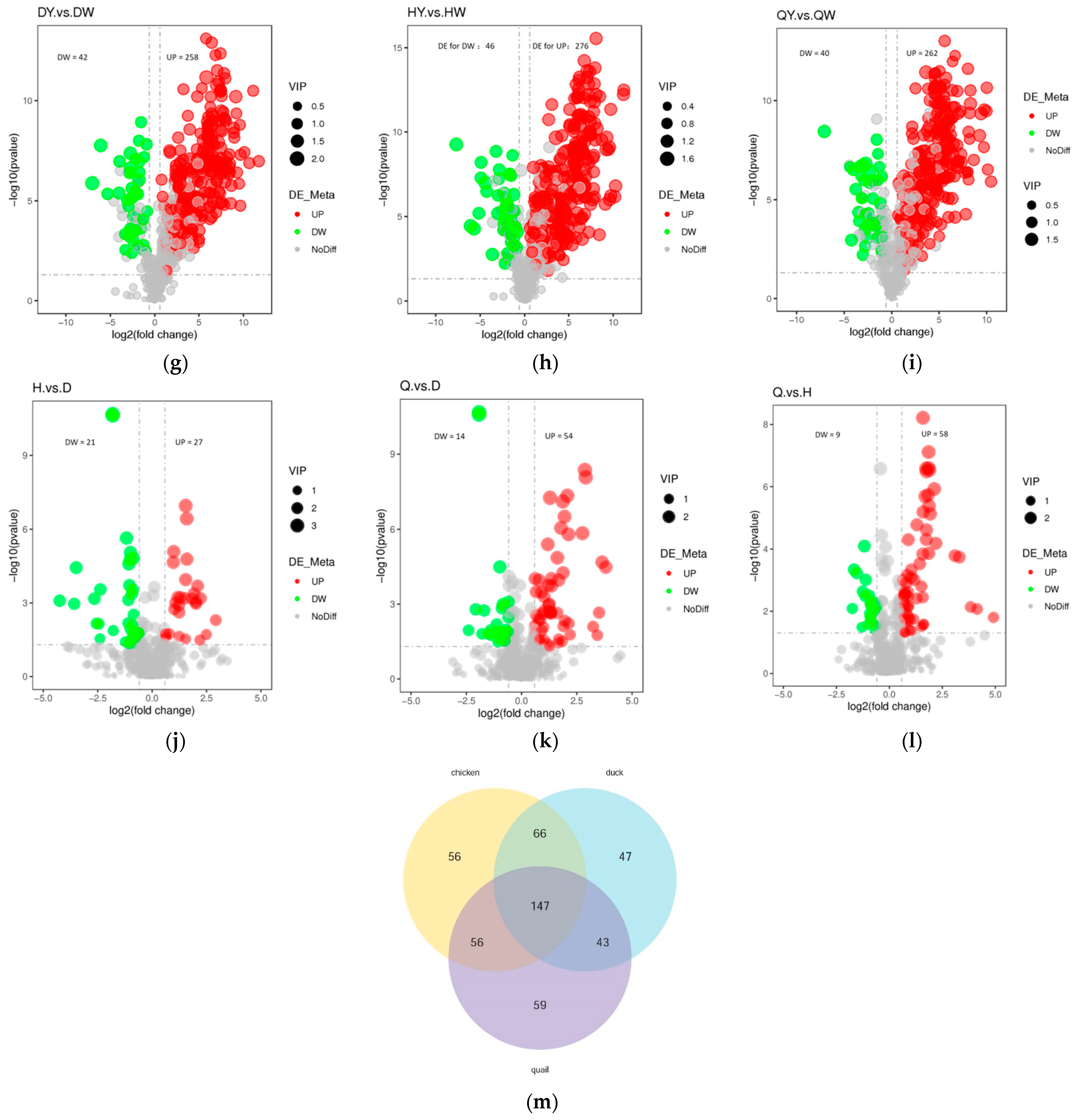
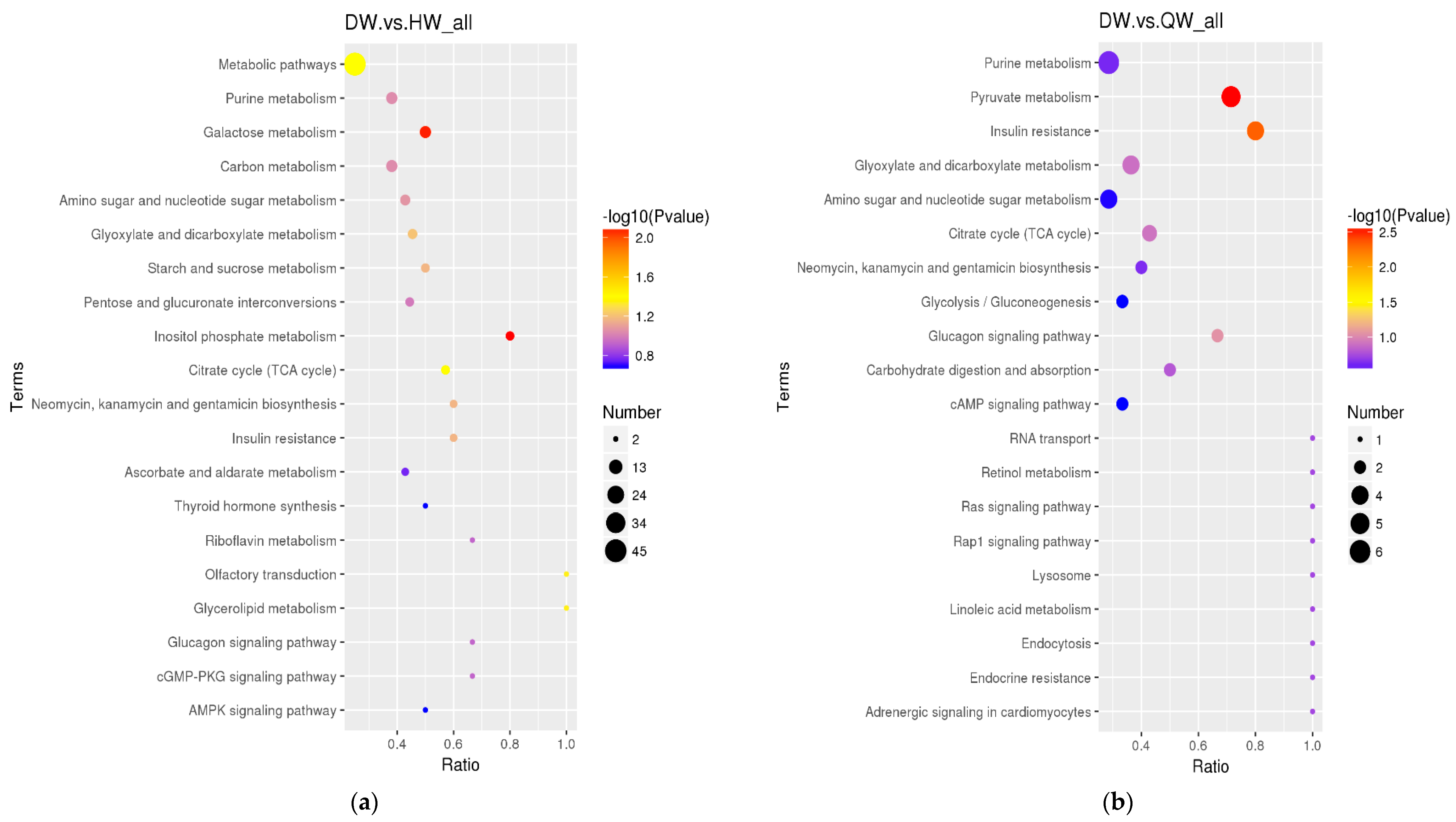
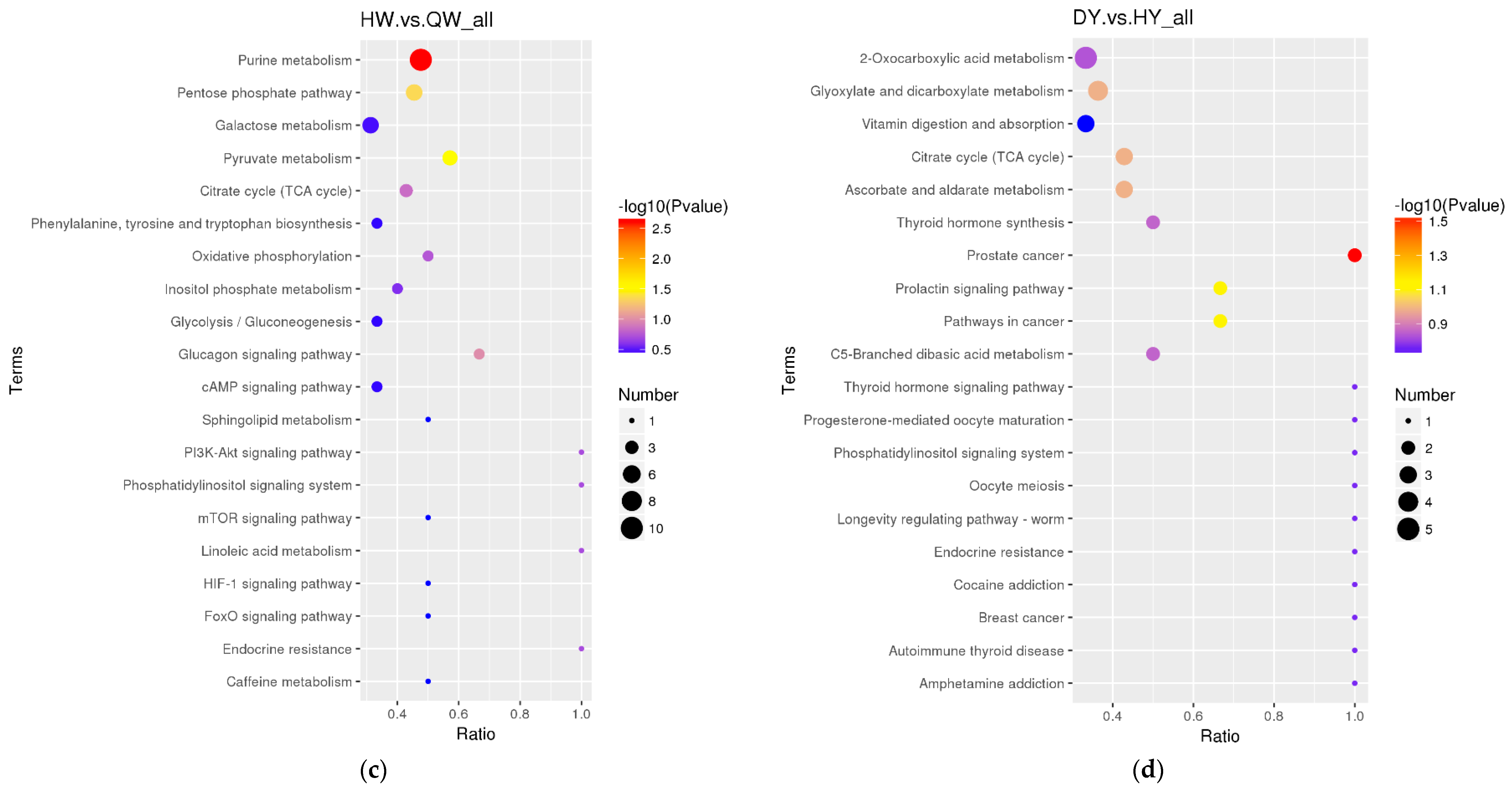

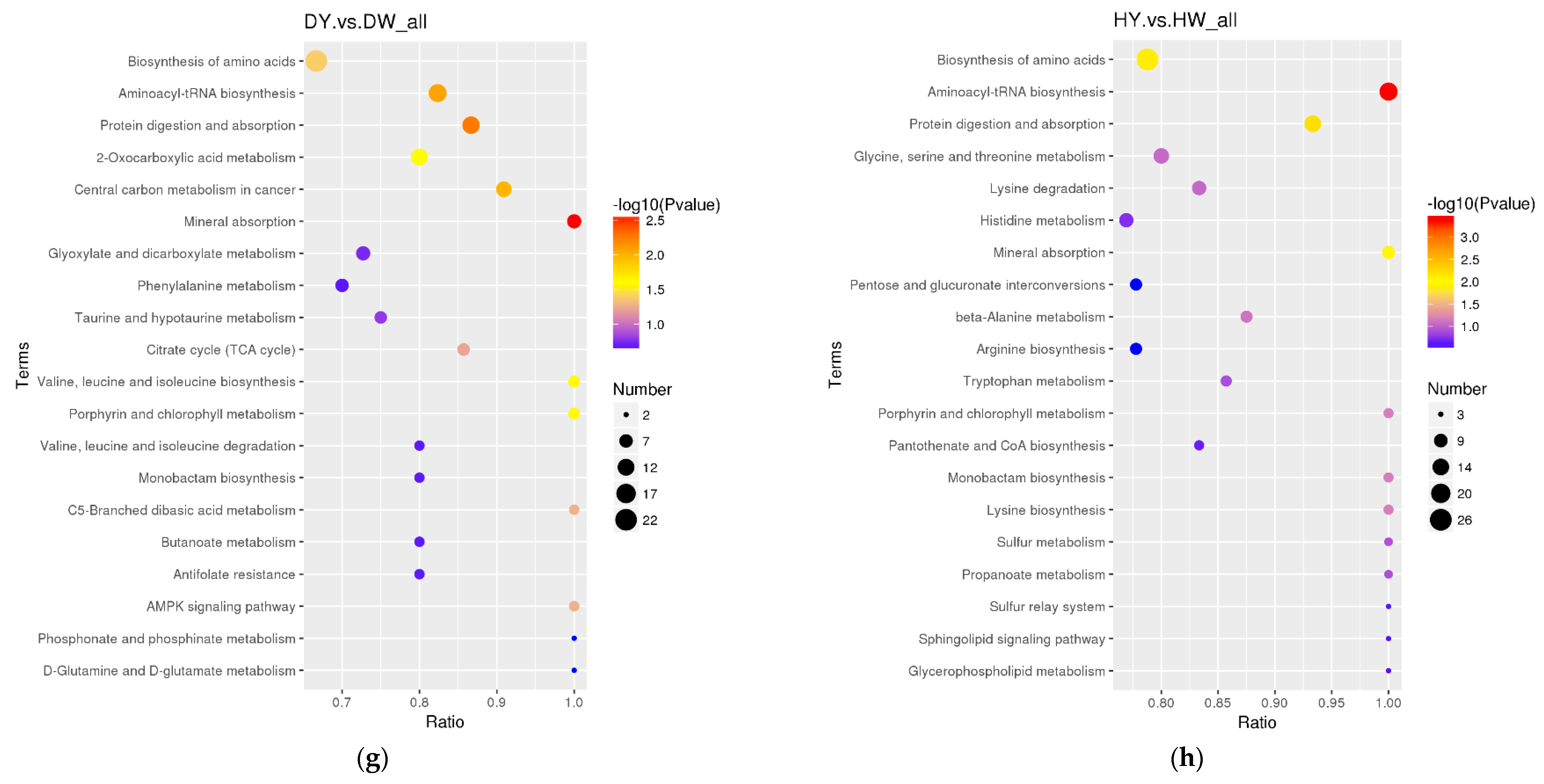
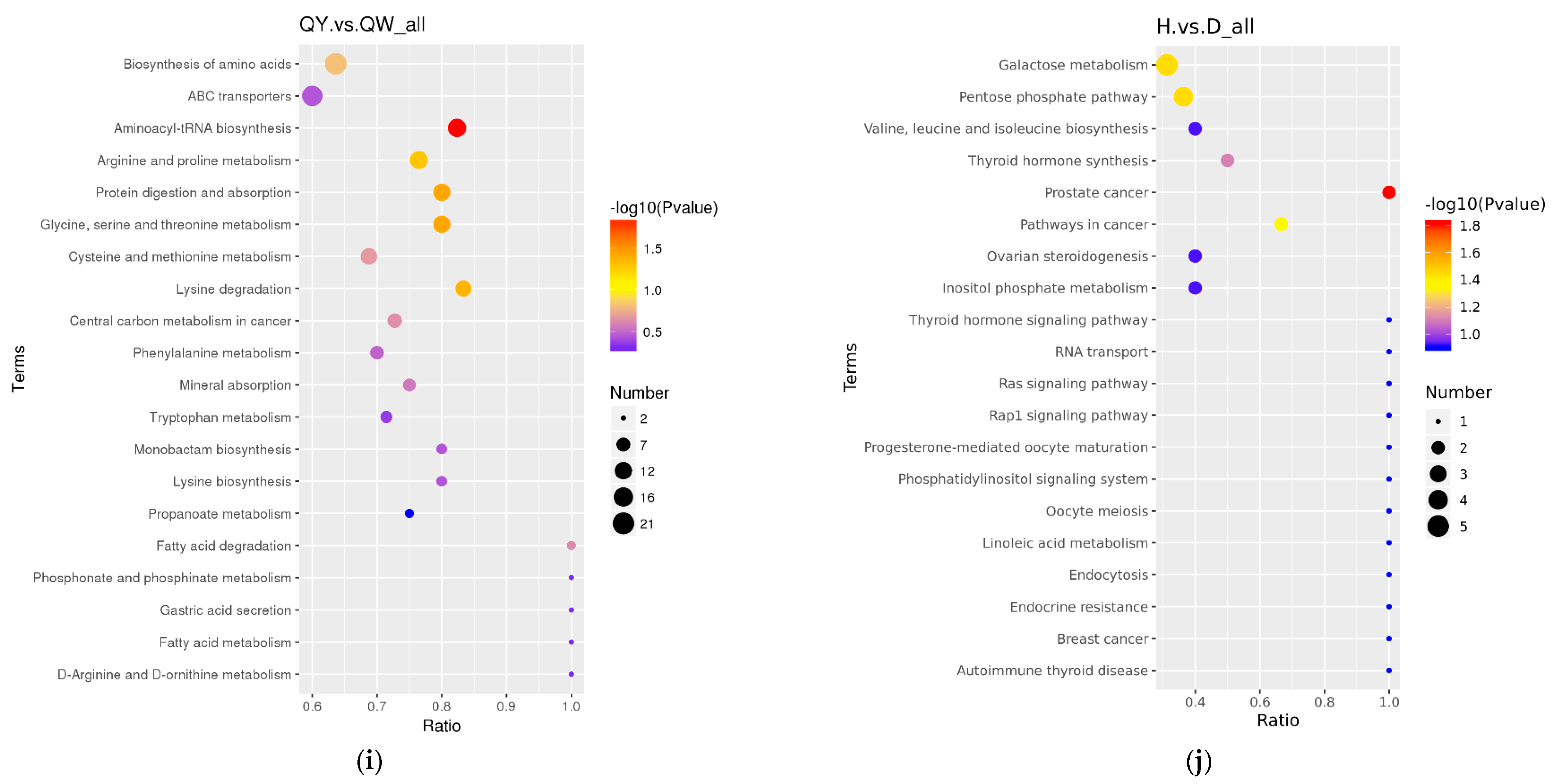
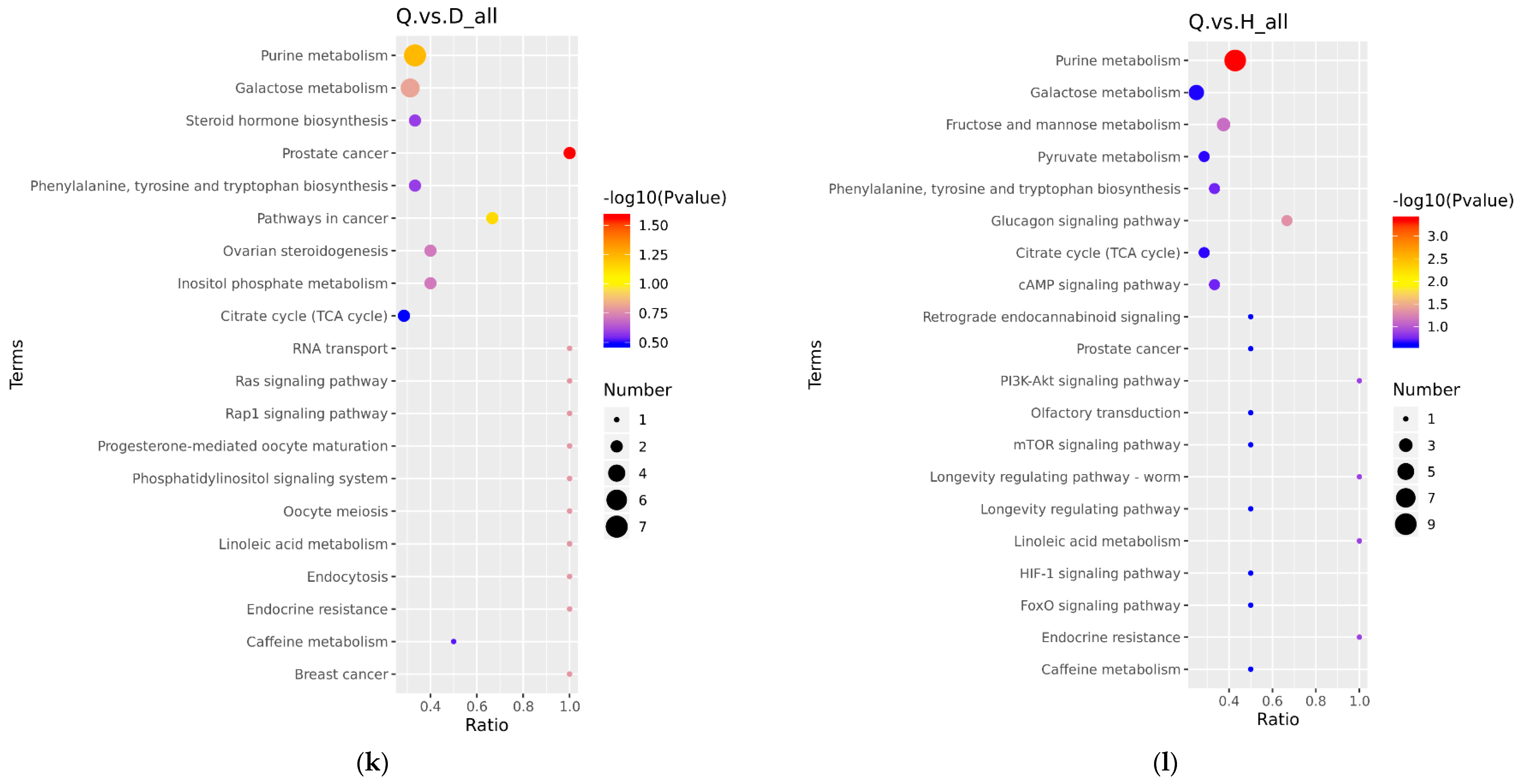
| Compared Samples | Num. of Total Ident. | Num. of Total Sig. | Num. of Sig. Up | Num. of Sig. Down |
|---|---|---|---|---|
| QY. vs. QW_all | 617 | 302 | 262 | 40 |
| HY. vs. HW_all | 617 | 322 | 276 | 46 |
| DY. vs. DW_all | 617 | 300 | 258 | 42 |
| HW. vs. QW_all | 617 | 92 | 35 | 57 |
| DW. vs. QW_all | 617 | 100 | 46 | 54 |
| DW. vs. HW_all | 617 | 108 | 57 | 51 |
| HY. vs. QY_all | 617 | 99 | 32 | 67 |
| DY. vs. QY_all | 617 | 112 | 56 | 56 |
| DY. vs. HY_all | 617 | 94 | 63 | 31 |
| H. vs. D._all | 617 | 48 | 27 | 21 |
| Q. vs. D._all | 617 | 68 | 54 | 14 |
| Q. vs. H._all | 617 | 67 | 58 | 9 |
Disclaimer/Publisher’s Note: The statements, opinions and data contained in all publications are solely those of the individual author(s) and contributor(s) and not of MDPI and/or the editor(s). MDPI and/or the editor(s) disclaim responsibility for any injury to people or property resulting from any ideas, methods, instructions or products referred to in the content. |
© 2023 by the authors. Licensee MDPI, Basel, Switzerland. This article is an open access article distributed under the terms and conditions of the Creative Commons Attribution (CC BY) license (https://creativecommons.org/licenses/by/4.0/).
Share and Cite
Wu, Y.; Xiao, H.; Zhang, H.; Pan, A.; Shen, J.; Sun, J.; Liang, Z.; Pi, J. Quasi-Targeted Metabolomics Approach Reveal the Metabolite Differences of Three Poultry Eggs. Foods 2023, 12, 2765. https://doi.org/10.3390/foods12142765
Wu Y, Xiao H, Zhang H, Pan A, Shen J, Sun J, Liang Z, Pi J. Quasi-Targeted Metabolomics Approach Reveal the Metabolite Differences of Three Poultry Eggs. Foods. 2023; 12(14):2765. https://doi.org/10.3390/foods12142765
Chicago/Turabian StyleWu, Yan, Hongwei Xiao, Hao Zhang, Ailuan Pan, Jie Shen, Jing Sun, Zhenhua Liang, and Jinsong Pi. 2023. "Quasi-Targeted Metabolomics Approach Reveal the Metabolite Differences of Three Poultry Eggs" Foods 12, no. 14: 2765. https://doi.org/10.3390/foods12142765
APA StyleWu, Y., Xiao, H., Zhang, H., Pan, A., Shen, J., Sun, J., Liang, Z., & Pi, J. (2023). Quasi-Targeted Metabolomics Approach Reveal the Metabolite Differences of Three Poultry Eggs. Foods, 12(14), 2765. https://doi.org/10.3390/foods12142765





